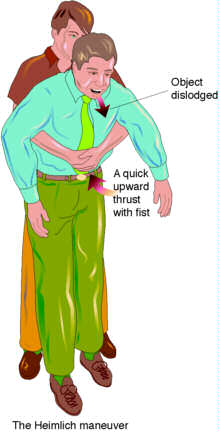

 To perform the Heimlich maneuver on a conscious adult (as illustrated above), the rescuer stands behind the victim and encircles his waist. The rescuer makes a fist with one hand and places the other hand on top, positioned below the rib cage and above the waist. The rescuer then applies pressure by a series of upward and inward thrusts to force the foreign object back up the victim's trachea. |
Every year about 3,000
adults die because they accidentally inhale rather than swallow food. The
food gets stuck and blocks their trachea, making breathing impossible.
Death follows rapidly unless the food or other foreign material can be
displaced from the airway. This condition is so common it has been
nicknamed the "cafe coronary."
In 1974 Dr. Henry Heimlich first described an emergency technique for expelling foreign material blocking the trachea. This technique, now called the Heimlich maneuver or abdominal thrusts, is simple enough that it can be performed immediately by anyone trained in the maneuver. The Heimlich maneuver is a standard part of all first aid courses. The theory behind the Heimlich maneuver is that by compressing the abdomen below the level of the diaphragm, air is forced under pressure out of the lungs dislodging the obstruction in the trachea and bringing the foreign material back up into the mouth. The Heimlich maneuver is used mainly when solid material like food, coins, vomit, or small toys are blocking the airway. There has been some controversy about whether the Heimlich maneuver is appropriate to use routinely on near-drowning victims. After several studies of the effectiveness of the Heimlich maneuver on reestablishing breathing in near-drowning victims, the American Red Cross and the American Heart Association both recommend that the Heimlich maneuver be used only as a last resort after traditional airway clearance techniques and cardiopulmonary resuscitation (CPR) have been tried repeatedly and failed or if it is clear that a solid foreign object is blocking the airway. |
|
| Full article found at the Health AtoZ site. |

